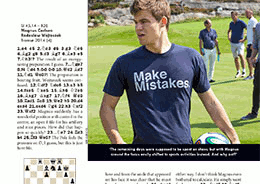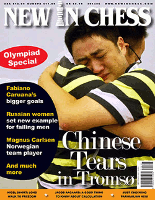Simply the Best
Review by Mark Donlan
New In Chess 2014/6, Dirk Jan Ten Geuzendam (ed.), New In Chess 2014, Paperback, Figurine Algebraic Notation, 106pp. $12.99 (ChessCafe Price $10.49)
Call me nostalgic, but I liked the old book-size format of New In Chess magazine. It was more portable, fit on the bookshelf, and was easier to store away by placing a full year of issues into an air-tight plastic bag. The new, larger magazine-size issues just wind up strewn randomly across my library. Nevertheless, while the format may have changed, the content is as excellent as ever. New In Chess remains the best chess magazine in print. It may also be the most expensive. A one-year subscription (eight issues) now costs $89.99 (about $11.25 per issue), even for the digital subscription alone. A combined print and digital subscription is $113.99 for eight issues.
New In Chess 2014/6 has just become available for single issue purchase, though subscribers have already had it for some time. The main content is as follows:

“After the Gold Rush” is the name of the two-page photograph that adorns the opening pages of this issue. A new photo is featured every month. This time around it is of Mongolian miners who live without electricity and play chess as long as the sun allows.
“NIC’s Café” is a collection of news tidbits from around the globe that caught the editorial teams interest; often of a gossipy nature.
“Fair & Square” is a one-page collection of chess quotes apropos to the news and events of the day.
“Goodbye to Tromso” is Dirk Jan Ten Geuzendam’s wrap-up of the 41st Chess Olympiad in Tromso. One that “will be remembered for the heart-warming cheerfulness of hundreds of volunteers, but also for a venue that did not really befit a top sporting event.”

“All for One, One for All” is the report on the Chinese men’s team first ever Olympiad victory with annotations from the players.
“Russian Women Win Again” is the report on the Russian women’s team Olympiad victory, written by assistant coach Evgeny Najer, and accompanied by annotations from the players.
“Long Walk to Freedom” is Nigel Short riveting essay on the FIDE elections. Short’s editorials probably prompt the most letters to the editor in each subsequent issue.

“Good at Feeling Free” is Simen Agdestein’s report on the Norway 1 team at the Tromso Olympiad, including Magnus Carlsen’s participation.
“Olympiad Highlights” is a selection of Olympiad games with notes from editor-in-chief Jan Timman, contributing editor Anish Giri, Rustam Kasimdzhanov, and Sam Shankland.
“The Chess Book of the Decade” is Jacob Aagaard’s look at the best book on decision-making, which it turns out is not a chess book at all.

“Caruana Wins in Kramnik Town” is Dirk Jan Ten Geuzendam’s report on the Dortmund tournament, won by Fabiano Caruana with a magnificent 2934 performance rating. The coverage includes an annotated game from Caruana and Georg Meier’s notes to his sensational win over Kramnik.
“Beware: Brilliancy” is Yochanan Afek’s selection of might-have-been brilliancies from contemporary play that were overlooked by the players.
“MVL Now Aka Mr.Biel” is Anish Giri’s report on the Biel tournament won by Maxime Vachier-Lagrave, with annotations from Giri and the tournament winner.
“The Great Folly” finds Hans Ree reviewing A.J.Gillam’s Mannheim 1914 and the Interned Russians: “a mixed bag of a traditional tournament book and a source book, with hundreds of fascinating stories.”
“Bu Untouchable” is Jan Timman’s overview of the Politiken Cup won by Bu Xiangzhi, who “unlike other Chinese GMs, plays a very classical kind of chess.”
“Just Checking” resides on the final page of every issue, but is where I usually turn to first. This feature lets you get to know chess personalities on a more informal level through a series of questions, such as favorite color, most exciting game, greatest fears, etc.
New In Chess magazine is so engrossing that I wish I could take the day off whenever it arrives to savor the issue from cover to cover. Article after article is enthralling reading. The tournament reports transport you to the event so much so that you feel you are in attendance; Nigel Short’s editorials, occasionally controversial, provide an inside look into the, often corrupt, machinations of the chess world; and having the best players on the planet annotate their own games is just icing on the cake. If you don’t subscribe at least do yourself the favor of picking up an issue now and then.
My assessment of this product:
![]()
Order New In Chess 2014/6
by Dirk Jan Ten Geuzendam (ed.)
A PDF file of this week’s review, along with all previous reviews, is available in the ChessCafe.com Archives.
© 2014 ChessEdu.org. All Rights Reserved.




Leave a Reply